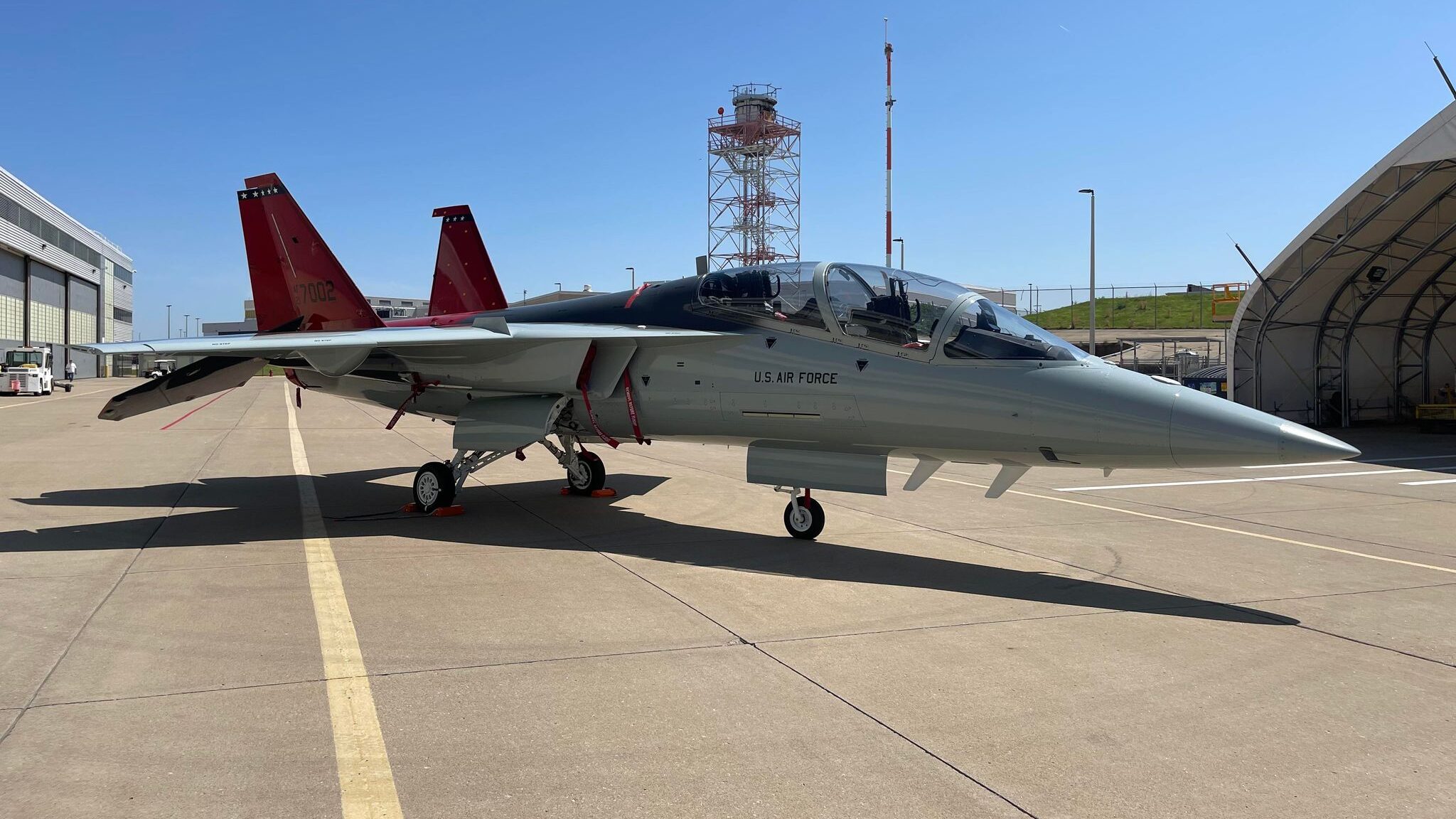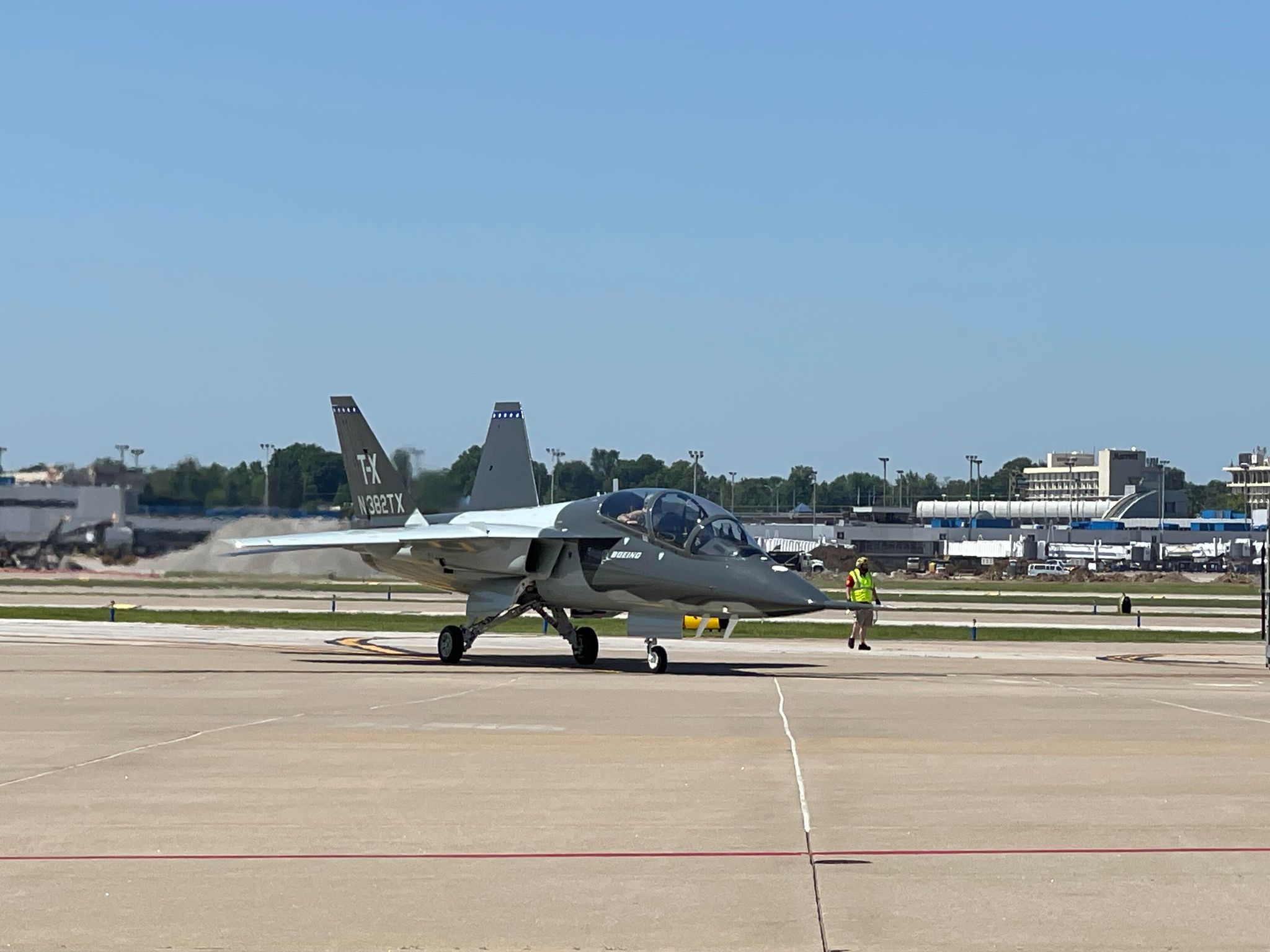
A Boeing-Saab EMD jet at the company’s facility in St. Louis. The Air Force will soon take possession of the jet for flight testing. (Michael Marrrow / Breaking Defense)
ST. LOUIS — Following a government watchdog report that warned of a “tenuous” relationship between the Air Force and Boeing over delays for the T-7A Red Hawk training jet, a top Air Force official is pushing back, telling Breaking Defense that the two parties have a solid relationship.
“I’d say our relationship is not tenuous. My relationship with my counterpart and my [program executive officer’s, or PEO’s] relationship with his counterpart are actually fantastic,” Col. Kirt Cassell, chief of the T-7A Red Hawk division, told Breaking Defense in a May 23 interview. “Collectively, the Air Force and Boeing have had some leadership changeover occur recently. And we are really hitting our stride together as a team.
“This is a fixed price contract, and with that, there could be a perception that the losses are driving a tenuous relationship,” he added, referencing the $1.1 billion Boeing has lost on the program to date, “but I’ll be honest with you, I’m really pleased with my counterpart. I know my PEO is terribly pleased with his counterpart.”
Cassell’s comments come at a critical point for the T-7A, which is over two years behind schedule as the Air Force seeks to retire an aging fleet of T-38 Talons. Boeing executives, speaking to media during a recent visit to Boeing’s facilities in St. Louis where the Red Hawk is built, emphasized that progress made to date has reduced the likelihood for more intensive changes that could further drag out the trainer’s development and force it to miss a production decision date set for February 2025. (Like other media, Breaking Defense accepted accommodations from Boeing for the visit.)
And even as they expressed confidence about the program’s path ahead, Boeing officials still acknowledged more time may be required to work through design changes, which the Air Force has allocated a full year of schedule margin beyond February 2025 to facilitate.
“There’s flexibility to go left too,” Donn Yates, Boeing’s T-7A business development director, said in a briefing with reporters. “There’s flexibility to go right based on what we see in [engineering and manufacturing development, or EMD].”
But with hundreds of test flights on Boeing’s production-representative jets (PRJs) under the program’s belt, officials are cautiously optimistic as the Air Force prepares to take possession of the jets for their own flight testing.
“We think when we get to the EMD, hopefully,” Yates said, pausing to knock on wood, “we’re going to be good because a lot of great people are working on it together, both on the Air Force side and Boeing.”
Top Schedule Risks: Escape System and Flight Software
As the May report from the congressional watchdog [PDF] lays out, a top schedule risk for the program is the qualification of its emergency escape system. Although test results have shown improvement in the system, more work is needed to address lingering issues with its activation.
To start, the system’s canopy fracturing system still poses a risk of concussing pilots, which occurs when a blast cord that punches a hole in the canopy glass explodes. Cassell said the program reduced the explosives in the blast cord for the February sled test by approximately 30%, leading to an about 30% reduction in pressure that “is much better for the pilot environment,” though officials are still reviewing data to determine how that translates to reduced risk of concussions.
As Cassell explained, “there’s this balance between making the hole big enough to get the seat through so that the pilot doesn’t impact by any large pieces. But then also, you want to balance that with the pressure.”
Jim Young, Boeing’s program director for the escape system, said many options are on the table when asked what further adjustments to the blast cord could be made, such as varying the amount of explosives or changing its position on the canopy.
“That trade space is open,” he said. “We were happy with what we did in the February test. We’re looking, do we tweak it some more, and either lower it a bit or raise it up just a bit to make sure we get the system working properly together.”
For parachute deployment, a key risk to pilots at the mercy of high g-forces, Cassell explained that the program made changes to how the seat slows itself after ejection with a drogue chute and when to deploy a parachute for the pilot. The ACES 5 ejection seat “is a flying craft, for lack of a better term. And with that it has an air data system, which takes in its altitude and airspeed,” he said.
The process is of particular concern for pilots on the lower end of the weight distribution, Cassell said, since “when that drogue chute deploys, or when that parachute deploys, the impact on a low-weight pilot is more harsh.”
The improvement for the February test, he said, was “improv[ing] the logic to make sure it’s selecting the correct mode.”
Cassell acknowledged that “I think Boeing and the Air Force agree that it took longer than it should have” to achieve design changes for the escape system, referring to a 15-month pause in the program’s sled testing, but the colonel and Young both said that remaining changes will not take nearly as long since the most significant alterations were achieved for the February test.
“The changes that I see occurring I think are, for lack of a better word, kind of on the margins,” Cassell said. “You know, some software here, maybe some minor hardware here and there, but not a whole lot. I think we’re close and I’m confident that we’ll be able to qualify this system prior to our milestone C date out there in February [20]25.”
Another leading schedule risk is deficiencies that could be encountered during upcoming flight tests led by the Air Force, which the Government Accountability Office warned may need as many as five-to-six additional software iterations to correct. Cassell, however, emphasized the value of Boeing’s PRJ flights.
“I agree with Boeing 100 percent. These production-representative jets that were part of this program from inception have really helped us to understand the system,” he said.
And while he stated previous PRJ flights have significantly reduced the likelihood of unwelcome new information, “I do have an expectation that we will most likely have discovery when we’re flying our EMD jets in flight test,” he cautioned. “And then we’ll just work collaboratively as a team to very quickly come up with a resolution and implement it and get back to flight testing.”

A Boeing PRJ aircraft lands at the company’s facilities in St. Louis. Boeing is pursuing as many flights with these aircraft as possible to assess the T-7A’s performance. (Michael Marrow / Breaking Defense)
The Air Force’s First Flight
By mid-June, Boeing officials said, Air Force pilots are planned to arrive in St. Louis to start mixed flights with company crews, a step toward transferring five of the EMD jets to Edwards Air Force Base for service-led testing.
Boeing crews will remain “deeply involved in that program the whole way through,” said Dan Draeger, the company’s chief test pilot for tactical fixed-wing aircraft. The first EMD jet is planned to arrive at Edwards this fall, he said, with the others to follow.
GAO warned that maintenance issues may cause delays for those EMD flight tests, with the report highlighting the need for Boeing to cannibalize parts from one of its PRJs so that the other could fly.
The PRJs are “not what we’re delivering to the United States Air Force,” Yates said. “They built a lot of the stuff and the equipment to get them done fast. And that’s not the stuff that is gonna go in the actual jet. So when we’re cannibalizing for the PRJs sometimes that’s what we have to do because we only have a set amount of displays, et cetera,” he said, adding that “has nothing to do with the way we’re going to employ the jet in the future.”
Should those EMD flights go relatively smoothly alongside development of the escape system, the program may just meet the February 2025 production date or possibly beat it. To do so, Boeing has begun ordering long-lead parts, a plan which GAO found does not enable the Defense Contract Management Agency to conduct oversight through its normal mechanisms since a production contract has not been issued.
When asked about issues with production oversight, Yates conceded “It’s all valid,” adding “that is something everybody is trying to figure out.
“If in fact we get through EMD and there’s a possibility that we could deliver earlier, we’re going to try to do that,” he continued, acknowledging “there is risk to that based on monitoring.”
Still, he assured officials would find a way forward.
“We’re working together. They’re going to figure it out,” he said. “So, we just need to get this going and get flying. The rest will take care of itself.”
Air Force picks Anduril, General Atomics for next round of CCA work
The two vendors emerged successful from an original pool of five and are expected to carry their drone designs through a prototyping phase that will build and test aircraft.


























